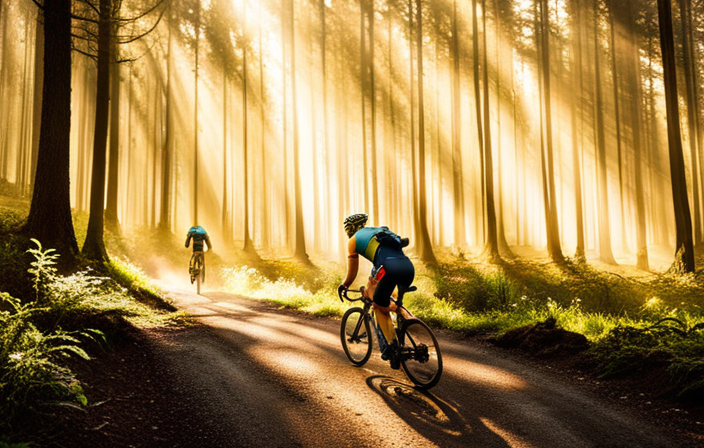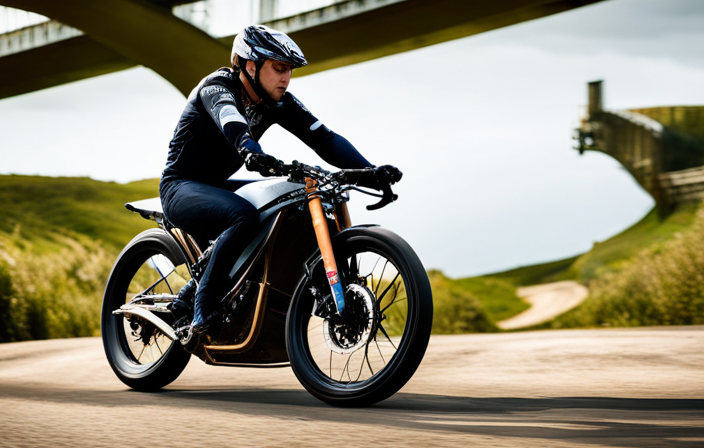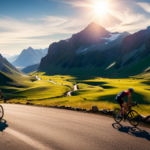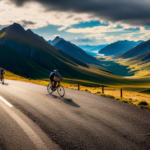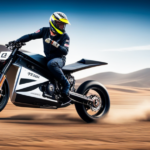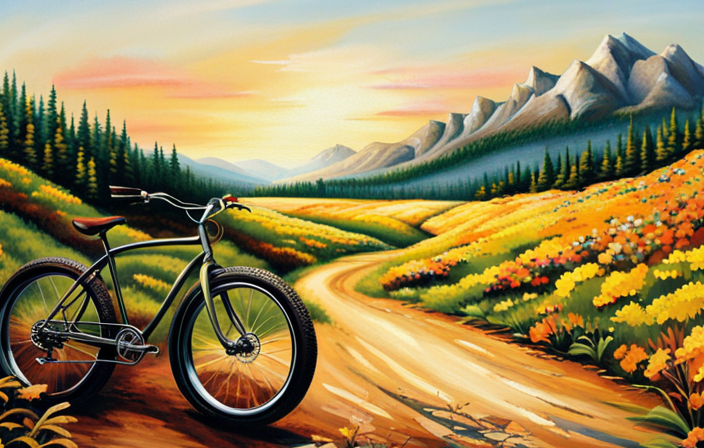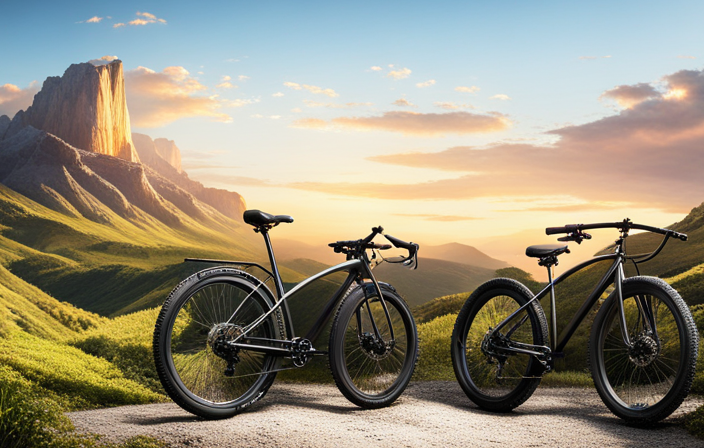Buckle up for an awesome journey into the heart of gravel bike racing! It’s like zooming down a rampaging river, cutting through fresh, uncharted territory. This epic adventure blends the untamed joy of cycling off the beaten path with the heart-racing thrill of competition.
In this article, I will take you on a journey to discover the history, equipment, training tips, and benefits of gravel bike racing.
So hop on your saddle and let’s dive into this exciting world where adventure meets competition.
Key Takeaways
- Gravel bike racing originated in the early 2000s as a grassroots movement and attracts avid cyclists seeking new challenges.
- Gravel bike races showcase rural landscapes, promote exploration, and forge connections with local communities, boosting tourism and the local economy.
- Gravel bike racing provides physical and mental challenges, improving cardiovascular endurance, building strength in various muscle groups, and improving overall fitness and stamina.
- To excel in gravel bike racing, riders need a well-maintained bike, suitable equipment and gear, proper training and techniques, and a focus on safety, race preparation, and nutrition.
History and Origins of Gravel Bike Racing
You might be interested to know that the history and origins of gravel bike racing can be traced back to the early 2000s. It all started as a grassroots movement, with avid cyclists seeking new challenges beyond traditional road cycling or mountain biking. Gravel bike racing events began popping up across the United States, attracting a niche group of riders who craved adventure on two wheels.
What sets gravel bike racing apart is its impact on local communities. These races often take riders off paved roads and onto less-traveled paths, showcasing the beauty of rural landscapes and encouraging exploration of hidden gems in small towns. As participants pedal through these areas, they not only compete against each other but also forge connections with residents who line the routes, cheering them on and providing much-needed support.
These events have become more than just races; they’re now an opportunity for communities to come together and celebrate their shared love for cycling. Local businesses thrive during race weekends as racers and spectators fill hotels, restaurants, and shops. The positive economic impact has led many towns to actively promote gravel bike races as a way to boost tourism.
As we move into discussing the equipment and gear needed for gravel bike racing, it’s important to understand the rich history behind this unique form of cycling competition.
Equipment and Gear Needed for Gravel Bike Racing
To compete in gravel bike racing, all you need is the right equipment and gear. As a gravel racer myself, I understand the importance of having top-notch gear to tackle the challenging terrains and unpredictable conditions.
Here are three essential items that every gravel bike racer should have:
-
Bike Maintenance: A well-maintained bike is crucial for a successful race. Regularly check your tires for wear and tear, adjust your brakes and gears, and keep your chain properly lubricated. It’s also important to carry a basic tool kit with spare tubes, tire levers, and a multi-tool for any on-the-go repairs.
-
Essential Accessories: Gravel racing often takes riders through remote areas with limited support. Therefore, it’s vital to have accessories like a saddlebag or frame bag to carry extra food, water bottles, and clothing layers. Don’t forget lights for early morning or late evening rides when visibility might be low.
-
Protective Gear: Safety should always be a priority when racing off-road. Invest in a good quality helmet that fits properly and consider wearing knee pads or elbow guards for added protection.
Now that you have the right equipment and gear sorted out, let’s dive into training tips and techniques for gravel bike racing seamlessly without missing a beat!
Training Tips and Techniques for Gravel Bike Racing
Looking to improve your skills and performance on the gravel? Here are some training tips and techniques that can help you excel in your next race. One of the key aspects of gravel bike racing is hill climbing. To become a strong climber, it’s important to incorporate both strength and endurance training into your routine. Focus on exercises such as hill repeats, where you tackle steep inclines repeatedly, to build leg strength and power. Additionally, interval training can help improve your cardiovascular fitness, allowing you to maintain a steady pace uphill.
Another crucial skill for gravel bike racing is mastering cornering techniques. When navigating tight turns on uneven terrain, it’s essential to have good bike handling skills. Practice leaning into corners while maintaining balance and control over your bike. You can also work on improving your line selection by studying the course map beforehand and visualizing the ideal trajectory through each turn.
To further enhance your understanding of these concepts, refer to the table below:
| Training Tips for Hill Climbing | Training Tips for Cornering Techniques |
|---|---|
| Incorporate hill repeats | Practice leaning into corners |
| Focus on strength and endurance | Improve line selection |
| Train with interval workouts | Visualize ideal trajectory |
By incorporating these training tips and techniques into your routine, you’ll be better prepared for the challenges of gravel bike racing. Now let’s move onto choosing the right bike for this exciting discipline without wasting any time!
Choosing the Right Bike for Gravel Bike Racing
When considering your options, it’s important to find a bike that is specifically designed for the demands of off-road riding on rough and unpaved surfaces. Here are three key factors to consider when choosing the right bike for gravel bike racing:
-
Bike Maintenance: Gravel bike racing can be tough on your equipment, so it’s crucial to choose a bike that is durable and easy to maintain. Look for a frame made from strong materials like aluminum or carbon fiber, as they offer excellent strength-to-weight ratios. Additionally, consider bikes with internal cable routing to protect them from dirt and debris.
-
Choosing the Right Gear: Gravel bike racing involves tackling various terrains, including steep climbs and fast descents. Therefore, opt for a bike with a wide gear range that allows you to conquer both uphill sections and flat stretches with ease. A compact crankset paired with a wide-range cassette will provide you with the necessary gearing options.
-
Attention to Detail: Pay attention to features such as tire clearance and frame geometry when selecting a gravel racing bike. Look for wider tire clearance (at least 40mm) as this will provide better traction on loose surfaces. Additionally, choose a bike with relaxed geometry that offers stability without sacrificing agility.
By carefully considering these factors, you’ll be well-equipped for gravel bike racing adventures ahead! Now let’s explore different types of gravel bike races…
Exploring Different Types of Gravel Bike Races
There are various types of events that cater to off-road cycling enthusiasts who enjoy the challenges and excitement of gravel bike races. Gravel bike race formats vary, offering a wide range of experiences for riders of all skill levels.
One popular format is the traditional gravel grinder, which involves long-distance rides on unpaved roads with varying terrain. These races can span anywhere from 50 to 200 miles and require strategies for pacing in order to endure the distance.
Another type of gravel bike race is the criterium-style event, where riders complete multiple laps on a shorter course. This format emphasizes speed and agility, as riders navigate through tight corners and sprint towards the finish line. Criterium-style races are fast-paced and highly competitive, requiring quick decision-making and precise handling skills.
Endurance events, such as ultra-endurance or multi-day stage races, test not only physical stamina but also mental fortitude. These races often cover hundreds of miles over several days, pushing participants to their limits.
Mastering different race formats requires understanding how to pace oneself effectively throughout the course. By strategically conserving energy during flat sections and powering through climbs or technical sections, riders can maximize their performance.
Transitioning into techniques for riding on rough terrain, it’s important to develop skills that allow you to confidently tackle any obstacles you may encounter on the trail without sacrificing speed or control.
Techniques for Riding on Rough Terrain
Now that we have explored different types of gravel bike races, let’s dive into the techniques for riding on rough terrain.
When it comes to gravel bike racing, having solid bike handling skills is crucial. Riding on unpredictable and uneven surfaces requires a different set of techniques compared to road cycling.
Firstly, maintaining a relaxed grip on the handlebars allows for better control and absorbs some of the vibrations from the rough terrain.
Secondly, shifting your weight back when descending steep sections helps maintain stability and prevents you from going over the handlebars. Additionally, keeping your eyes focused further ahead allows you to anticipate obstacles and choose the best line.
In terms of bike handling, it is important to learn how to navigate loose gravel and maintain traction while cornering. Feathering your brakes instead of applying them abruptly can prevent skidding and help maintain momentum. Moreover, practicing small hops or bunny hops can help you maneuver over larger obstacles like rocks or tree roots.
By mastering these riding techniques, you will be well-prepared to conquer challenging climbs in gravel bike racing.
So let’s gear up and get ready to tackle those mountains head-on!
Conquering Challenging Climbs in Gravel Bike Racing
To conquer challenging climbs in gravel bike racing, it’s essential to master the art of maintaining traction and momentum while navigating loose terrain. These climbs can be intimidating, but with the right training techniques, they can become opportunities for personal growth and achievement.
One effective technique is interval training, which involves alternating between periods of intense effort and recovery. This helps build both strength and endurance, allowing you to power through those steep ascents. Another important aspect is developing your climbing technique. Proper body positioning, such as shifting your weight forward and keeping a firm grip on the handlebars, will help you maintain control and stability on the rough terrain. Additionally, practicing climbing on different surfaces will enhance your adaptability and confidence when faced with various challenges during a race.
Transitioning into strategies for endurance and stamina in gravel bike racing, it’s crucial to remember that conquering challenging climbs is just one part of the overall equation. Endurance is key in gravel bike racing because these races often span long distances over varied terrain. Therefore, incorporating long rides into your training routine will help build up your stamina and mental resilience.
By combining these strategies with proper nutrition and hydration practices, you’ll be well-equipped to tackle even the most demanding gravel races with confidence.
Strategies for Endurance and Stamina in Gravel Bike Racing
Improve your endurance and stamina in gravel bike racing by incorporating long rides into your training routine. Endurance training is crucial for gravel bike racing because it requires sustained effort over long distances and challenging terrains. To build your endurance, gradually increase the duration and intensity of your rides. Start with shorter rides and slowly work your way up to longer distances, pushing yourself to ride at a slightly higher intensity each time.
In addition to endurance training, fueling strategies play a vital role in maintaining stamina during gravel bike races. It’s essential to properly fuel your body before, during, and after each ride. Make sure to consume a balanced meal rich in carbohydrates and protein before riding and stay hydrated throughout the race.
During longer rides, consider carrying energy gels or bars to provide quick energy boosts when needed. Experiment with different types of sports drinks or electrolyte supplements that can help replenish lost nutrients and keep you going strong.
To transition into the subsequent section about safety tips and precautions for gravel bike racing, remember that while building endurance is important, it’s equally crucial to prioritize safety on the road. So let’s delve into some key safety tips that will ensure you have a smooth and enjoyable gravel biking experience without any mishaps.
Safety Tips and Precautions for Gravel Bike Racing
Ensure your safety and minimize risks during gravel bike races by following these essential tips and precautions.
One of the most important aspects of safety in gravel bike racing is proper bike maintenance. Before each race, make sure to check your tires for any cuts or punctures, as well as ensuring that they are properly inflated. Inspect your brakes to ensure they are working effectively, and lubricate the chain to prevent any unnecessary wear and tear. Additionally, it is crucial to carry a basic repair kit with you during the race, including spare tubes, tire levers, and a multitool.
Emergency preparedness is another key component of staying safe during gravel bike races. Always carry a fully charged cell phone with emergency contacts saved in it. It’s also wise to bring along some form of identification in case of an accident. Familiarize yourself with the race course beforehand so you can anticipate any potential hazards or challenges.
In conclusion, taking care of your bike and being prepared for emergencies are vital for ensuring your safety during gravel bike races. By following these tips and precautions, you can enjoy the exhilaration of racing while minimizing the risks involved.
Now let’s transition into discussing nutrition and hydration for optimal performance on the racecourse without missing a beat!
Nutrition and Hydration for Gravel Bike Racing
As we gear up for the thrilling adventure of gravel bike racing, it’s essential to ensure that our bodies are properly fueled and hydrated. Pre-race fueling, hydration, and recovery strategies play a crucial role in maximizing performance and maintaining endurance throughout the race.
Before hitting the gravel roads, it is important to consume a balanced meal consisting of carbohydrates, proteins, and healthy fats. This will provide the necessary energy to power through the demanding course. Additionally, staying well-hydrated before the race is vital for optimal performance. Drinking plenty of water and electrolyte-rich fluids will help maintain proper hydration levels.
During the race itself, it’s imperative to keep replenishing your body with fluids and fuel. Sipping on water or sports drinks at regular intervals will prevent dehydration and maintain electrolyte balance. Carrying energy gels or bars can provide quick bursts of energy when needed.
Post-race recovery is just as important as pre-race preparation. Consuming a mix of carbohydrates and protein within 30 minutes after finishing helps kickstart muscle repair and glycogen replenishment. In addition, stretching and light exercises can aid in reducing muscle soreness.
Remember that maintaining an optimal electrolyte balance during gravel bike racing is crucial for overall performance. Now that we know how to properly fuel ourselves during races, let’s delve into recovering and resting techniques for gravel bike racing without missing a beat.
Recovering and Resting Techniques for Gravel Bike Racing
To effectively recover and rest after a challenging gravel bike race, you should prioritize getting enough sleep and engaging in low-impact activities like yoga or swimming. Recovering techniques play a crucial role in ensuring that your body heals and rebuilds itself after the demanding physical exertion of a race.
One important aspect of recovery is sleep. It is during sleep that your body repairs damaged muscles and replenishes energy stores. Aim for at least 7-8 hours of quality sleep each night.
In addition to sufficient sleep, incorporating resting strategies into your routine can also aid in recovery. Low-impact activities such as yoga or swimming can help loosen tight muscles, improve flexibility, and promote relaxation. These activities stimulate blood flow to the muscles while minimizing stress on joints and ligaments.
It’s important to listen to your body and give it the time it needs to recover fully. Pushing yourself too hard without allowing for proper rest can lead to overtraining syndrome or injury. So take the time to recover properly before jumping back into intense training.
Transition: Now that we’ve discussed recovering and resting techniques, let’s explore the benefits of gravel bike racing for physical fitness…
Benefits of Gravel Bike Racing for Physical Fitness
Recovering and resting techniques are essential for any athlete, and gravel bike racing is no exception. But what sets gravel bike racing apart is the incredible physical benefits it offers.
Gravel bike racing not only challenges your cardiovascular endurance but also builds strength in your legs, core, and upper body. The diverse terrain demands constant adjustments to balance and stability, engaging muscles you didn’t even know you had. It’s like a full-body workout on two wheels!
To maximize these physical benefits, incorporating proper training techniques is crucial. Interval training helps improve your speed and power on the bike, while strength training off the bike enhances overall muscle performance. Endurance rides build stamina and mental resilience for those long races.
I’ve found that following a structured training plan tailored specifically for gravel bike racing has greatly improved my fitness level. By gradually increasing mileage, intensity, and incorporating rest days, I’ve seen remarkable progress in my physical abilities.
But physical fitness alone isn’t enough to succeed in gravel bike racing – mental preparation and focus play a significant role as well. [Transition sentence into subsequent section about ‘mental preparation and focus for gravel bike racing.’]
Mental Preparation and Focus for Gravel Bike Racing
Mental preparation and focus are essential aspects for achieving success in gravel bike races. While physical fitness is crucial, having a strong mental game can make all the difference on race day.
To stay mentally sharp during a race, I employ various techniques that help me maintain focus and push through challenging moments.
One of the mental focus techniques I utilize is visualization. Before a race, I close my eyes and picture myself riding smoothly over the gravel terrain, feeling confident and in control. This helps me build self-belief and prepare for potential obstacles along the way.
Another important aspect of mental preparation is establishing pre-race rituals. These rituals create a sense of routine and familiarity, which can calm nerves and increase concentration. For example, I always arrive at the race venue early to familiarize myself with the course and warm up properly. Additionally, I have a specific playlist of upbeat songs that I listen to before each race to get into the right mindset.
By honing my mental focus techniques and sticking to my pre-race rituals, I am able to enter each gravel bike race with clarity and determination. With these tools in hand, I transition seamlessly into joining gravel bike racing communities and events where camaraderie fuels our shared passion for this exhilarating sport.
Joining Gravel Bike Racing Communities and Events
If you want to fully immerse yourself in the exhilarating world of gravel bike racing, joining communities and events is a great way to connect with fellow riders and share your passion for this thrilling sport. There are numerous benefits to becoming a part of these communities, including gaining valuable insights from experienced riders, discovering new bikepacking adventures, and finding training partners for gravel bike racing.
-
Learn from experienced riders: By joining gravel bike racing communities, you have the opportunity to learn from seasoned racers who can provide valuable tips and advice. They can share their experiences, techniques, and strategies that have helped them succeed in races.
-
Discover new bikepacking adventures: Being a part of these communities exposes you to exciting routes and trails that you may not have known about otherwise. You can exchange recommendations with fellow riders on the best spots for challenging rides or scenic landscapes perfect for an unforgettable journey.
-
Find training partners: Training with others who share your passion for gravel bike racing can be incredibly motivating. Joining events such as gravel bike racing training camps allows you to meet like-minded individuals who are dedicated to improving their skills and performance.
By connecting with these communities and participating in events, you’ll gain inspiration and insight into the world of gravel bike racing.
Transitioning into the subsequent section about ‘inspiring stories and profiles of gravel bike racers,’ we get a glimpse into how these passionate individuals have pushed boundaries and achieved remarkable feats on their bikes without losing sight of what makes this sport so special – the thrill of adventure combined with fierce competition.
Inspiring Stories and Profiles of Gravel Bike Racers
Immerse yourself in the world of gravel bike racing by exploring inspiring stories and profiles of racers who have achieved remarkable feats and pushed boundaries. These inspiring race stories showcase the determination, resilience, and passion that drive gravel bike racers to overcome obstacles and reach new heights.
One such story is that of Sarah, a mother of three who decided to take up gravel bike racing as a way to challenge herself physically and mentally. Despite juggling her responsibilities at home, she trained tirelessly and participated in her first race. Against all odds, she finished strong, proving that with dedication and perseverance, anything is possible.
Another inspiring racer is Mark, who lost his leg in a car accident but refused to let it define him. With the help of adaptive equipment and unwavering determination, he not only returned to racing but also became an advocate for inclusivity within the gravel biking community. His story serves as a powerful reminder that there are no limits when it comes to pursuing your passion.
These inspiring stories remind us that gravel bike racing is about more than just winning or setting records; it’s about pushing ourselves beyond our comfort zones and embracing challenges head-on. So next time you find yourself facing obstacles on your journey, remember these incredible racers who defied the odds and let their stories inspire you to keep pedaling forward.
Frequently Asked Questions
How do I prepare mentally for a gravel bike race?
To prepare mentally for a gravel bike race, I focus on developing mental toughness and using visualization techniques.
Mental toughness is crucial to push through the physical challenges and keep a strong mindset during the race. I visualize myself conquering tough sections of the course, maintaining a steady pace, and crossing the finish line with determination.
This helps me stay motivated, confident, and mentally prepared to tackle any obstacles that come my way during the race.
Are there any specific recovery techniques for gravel bike racing?
One recovery technique I swear by after a grueling gravel bike race is foam rolling. It helps release muscle tension and aids in faster recovery.
Another important aspect is nutrition strategies, such as consuming protein-rich foods within the first 30 minutes post-race to promote muscle repair.
Hydration is also crucial, so replenishing electrolytes with sports drinks or coconut water can aid in recovery.
Taking care of your body after a race is just as important as preparing mentally before it!
What are some tips for joining gravel bike racing communities and events?
When it comes to joining gravel bike racing communities and events, there are a few tips that can help you get started.
First, reach out to local cycling clubs or organizations that focus on gravel riding. They often have group rides and events where you can meet fellow riders.
Second, follow social media accounts and websites dedicated to gravel bike racing for updates on upcoming events.
Lastly, don’t be afraid to attend races even if you’re a beginner – the community is welcoming and supportive!
Can you share any inspiring stories or profiles of gravel bike racers?
I’ve come across some truly inspiring stories of gravel bike racers who have pushed their limits and achieved remarkable feats.
One profile that stands out is that of Sarah Sturm, a fierce competitor known for her unwavering determination. Despite facing numerous challenges, she has continued to excel in the world of gravel bike racing.
Her story serves as a testament to the resilience and passion exhibited by gravel bike racers, making them an exceptional group of athletes worth celebrating.
What are some lesser-known benefits of gravel bike racing for physical fitness?
Gravel bike racing offers a multitude of physical fitness benefits that are often overlooked.
First, gravel bike training provides an excellent cardiovascular workout, helping to improve endurance and stamina.
Additionally, the varied terrain and technical challenges of gravel racing engage different muscle groups, leading to improved overall strength and balance.
Lastly, proper nutrition for gravel racing plays a crucial role in fueling the body for optimal performance.
With a well-rounded approach to training and nutrition, gravel bike racing can truly transform your physical fitness journey.
Conclusion
In conclusion, gravel bike racing is a thrilling and challenging sport that combines the excitement of cycling with the thrill of off-road adventures. It requires dedication, discipline, and determination to conquer the rough terrain and push your limits.
By joining gravel bike racing communities and events, you can connect with like-minded individuals who share your passion for this unique sport. So grab your gear, hop on your bike, and embark on an adrenaline-fueled journey into the world of gravel bike racing!
Let’s pedal powerfully through picturesque paths and pursue our passions passionately!
